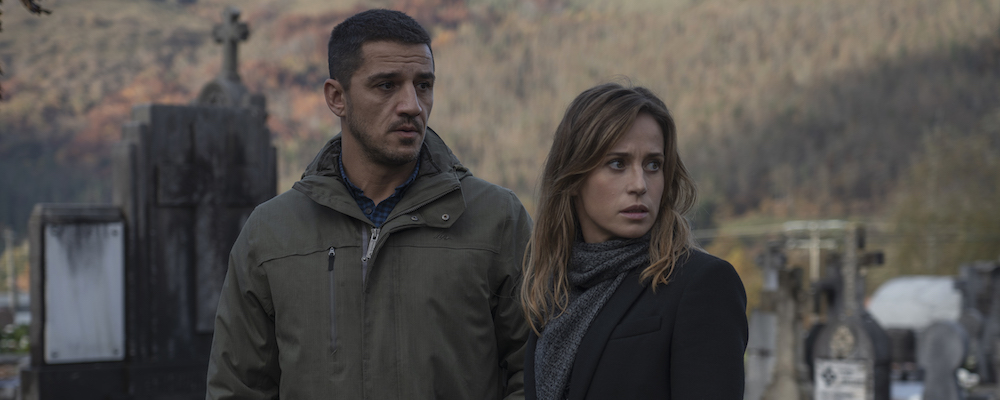Netflix’s ‘Offering to the Storm’ Brings a Bombastic Occult Ending to the ‘Baztan Trilogy’
Alci Rengifo
“Offering to the Storm” is one of the year’s most visually impressive exercises in silliness. Few films this year will look as elegant, all the while delivering an extremely archaic plot that makes witchcraft sound like a John Grisham plot. Fans, of course, will disagree. This is the third adaptation of the international bestselling “Baztan Trilogy” by Dolores Redondo. The tone of the novels is to combine Basque mythology with the usual trappings of a modern detective thriller. Told with flair, each movie is enveloping in its own way. This supposedly final chapter goes the longest, providing melodramatic occult answers.
Detective Amaia Salazar (Marta Etura) remains one of the world’s most cursed cops. Over the last two installments, “The Invisible Guardian” and “The Legacy of the Bones,” she has investigated gruesome murders in the valley of Baztan, all linked to a dark past concerning her mother, Rosario (Susi Sánchez). At the end of “Legacy of the Bones” Rosario had gone missing during a raging flood from a psychiatric facility. While Amaia’s siblings are convinced Rosario is dead, she is certain this is not the case. As established in the previous films, Rosario was linked to witchcraft, old rituals, and possible occult groups ancient to the valley. When infants begin turning up deceased, due officially to cot death, Amaia is on the case with regular partner Jonan (Nene). Quickly the deaths are linked to suspicions of a secret occult group linked to a mythic demon. Before long, Amaia is certain Rosario is involved. But as she digs deeper into the darkness, Amaia must also handle being a new mother herself, and the strain her life puts on romantic partner James (Benn Northover).
Like the previous two movies, “Offering to the Storm” is unabashed melodrama mixed with gothic fantasy. Director Fernando González Molina, who made the other installments as well, delivers the longest chapter yet at 2 hours and 19 minutes. Dolores Redondo’s books were essentially Spain’s answer to “The Girl with the Dragon Tattoo.” True crime-style intrigue is mixed with wider local history. But while the Stieg Larsson novels, and subsequent hit films, stayed grounded in reality, Redondo’s mixes the detective work with over-the-top, demonic tricks. Devoted readers of the books might enjoy these films the best, because by the last act you’ve lost track of who was involved with what witches. Much of it has to do with how the movies keep very vague precisely what the dark forces being battled are, or how they work. Early in this film Amaia interrogates a doctor, who was apparently Rosario’s Satanic accomplice at the psychiatric facility. He simply warns her that Rosario would like to kill her. Later he drops dead after foaming at the mouth in his cell. But we never learn if a curse was issued from afar, if it was Satan (who a priest constantly hints is the culprit here) doing a favor for his coven, or anything that would satisfy.
There is also a strange approach to the way characters relate to all this craziness around them. In the first movie Amaia’s brother-in-law turned out to be the brutal killer and rapist of several young girls. It ended in a bloody shootout, yet no one in Amaia’s family reflects or seems perturbed by this, even as each new movie picks up a month or two after the last one. James, Amaia’s American partner and artist, is the world’s most clueless boyfriend. Amaia has uncovered her family’s links to ancient Spanish witchcraft, battled several killers, witnessed explosions, found child corpses, has had friends butchered, yet he still wonders why she’s always having to go out. When he complains that Amaia is never around to take care of the baby, you wonder what planet this guy inhabits. There’s better romance in this installment with magistrate Juez Markina (Leonardo Sbaraglia) who is desperately in love with Amaia. This complicates work, although there is no apparent sense of unease when they sleep together, even after Markina reveals his father might have been linked to demon worship.
What excels in this chapter, as in the other ones, is director Molina’s love of dynamic, rich images. The cinematography by Xavi Giménez makes the Basque valleys of Spain look baroque, dreamy, glowing with oak-colored light. Nothing in this chapter tops the tremendous flood from the last movie, but it’s gorgeous to gaze at all the same. In a film about witches set in Spain, it makes sense that inspiration is surely taken from Goya for the aesthetic. The music by Fernando Velázquez envelopes the movie in menacing, orchestral waves of symphonic intensity.
For newcomers to this world, answers are somewhat delivered at the end of this movie, even if they remain a bit vague. A running theme has been Amaia’s disturbed childhood memories of Rosario being a demented, tyrannical mother. Many connections are finally made between her behavior and dark magic, rituals involving child sacrifices and unchained demonic forces. Some explanations are left up in the air, particularly on the supernatural elements. “The Invisible Guardian” did the same by establishing the presence of a Bigfoot-like Basque creature which appeared at the end, and never appeared again. Here some culprits are finally unmasked. Some will meet appropriately bloody ends. The cast delivers it all superbly well. Marta Etura could go up against any American female action lead, and it is always delight to see Itziar Aizpuru as Tia Engrasi, Amaia’s aunt who reads the cards, sensing spiritual realms.
“Offering to the Storm” will surely satisfy fans of the Baztan Trilogy who are devoted to its Satanic twists. The final installment requires that kind of commitment. Yet despite its bombast and quirks, as a visual experience it is memorable evoking black magic with artistic exuberance.
“Offering to the Storm” begins streaming July 24 on Netflix.

